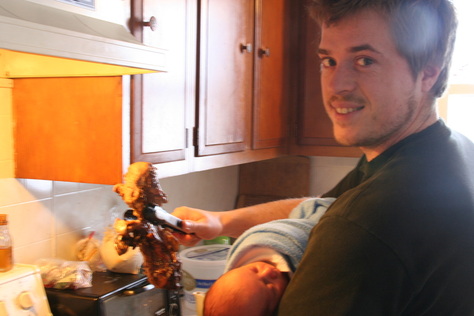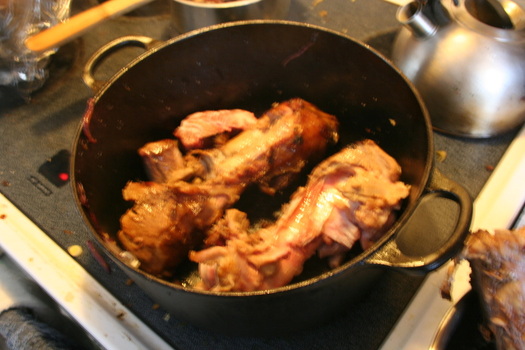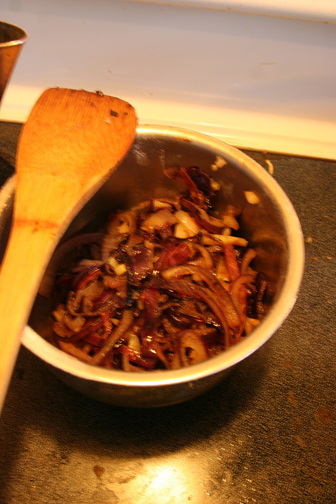|
Sautéing is one of the most primary tools in a chef's arsenal. For that reason there are many misconceptions about what it is and what it is not. It is: A way to heat food to a point where it begins to excrete juices and thus heat and caramelize the sugars. It is not: A way to "seal in the juices" on a steak or roast. It does quite the opposite; as the food cooks, flesh breaks and cracks and actually allows the meat to release more liquid. It is: A technique that, when used in tandem with other methods can produce exquisitely rich foods. It is not: Simply relegated to chicken breasts, hamburgers and onions. Building on our lesson "On Cooking", sautéing makes principle use of heat and moisture control. High Heat - Searing Searing is used when you want to brown the outside of something. The "brown" is actually fond. These are the juices of the item that are being released quickly from the food. With the juices are all sorts of compounds like fats and sugars and vitamins. These become super concentrated in the high heat of the pan and bind themselves to the item being cooked. In addition, the food itself is cooking rapidly which produces some really delicious flavors and does some great things texturally. *sidenote* I'm sure you've heard this but it really is genuinely dangerous to cook on Teflon cookware. Virtually all of the world has outlawed Teflon and the U.S. will follow suit by 2015. Teflon has been proven to cause cancer. In order to properly sear you need to use an oil that can take a pretty high heat (this is not EV Olive Oil, this should only be used for low heat cooking. Rule of thumb, if your EVOO is producing smoke, it's giving you cancer) like canola or (ideally) organic coconut oil. With your pan on high, add your oil (enough just to coat the bottom of the pan) and give it a few seconds to come up "to temp". Salt whatever you are about to sauté liberally. The salt will help draw out more liquid ("lysing") and thus more flavor. Depending on what you are cooking it is vital that you do NOT move it too much. You are simply trying to produce that outer crust. If the pan is not hot enough or you are constantly flipping it over and over, you will not maintain the high heat that is necessary for searing. If you are searing a steak or a roast, it should stay untouched for about 2 minutes per side (if it is a big roast like a rolled rump or sirloin tip, think of it like a cube being sure to take the time to sear every side). You will know that it is done when it releases easily from the pan (the food will form a bond with the pan and once a certain temperature is achieved, the bond breaks. Try and pull the food before then and half your steak will stay firmly stuck to the pan). If you are searing veggies, lay out a thin layer of whatever you are cooking. It is important that as much of them touch the pan as possible. If any are sitting atop one another then they are steaming and that is a different process (covered later). Scrape the pan with a wooden spatula until the veggies are a uniformed brown. What to do with it...
At this point you have several options. Your steak is ready to eat or broil, your roast is ready to be braised in the oven (don't forget to deglaze and loosen up all those tasty bits at the bottom) and your asparagus is ready to plate. Sautéing is a great way to offer up some very hearty flavors into dishes that seem to lack depth. Adding sautéd onions to just about anything with up the savory factor by like a billion (give or take). Low Heat - Sweating Sweating is used for a few different reasons. Principally for caramelizing (onions) but also for softening or producing pan juices. Regardless of the reason for sweating, the focus is controlling the moisture. You want to release as much of it as possible and in the case of caramelization you then reduce that liquid to break down and gently brown the sugars (caramel). When cooking with a low heat a chefs options for oil increase. Now you get to use the really tasty stuff: butter, EVOO and a few unrefined (read, "flavorful") oils. Also, it is important to salt liberally. You want to pull out as much moisture as possible and the salt will help with that. The trick to sweating is really just to let the food rest in a slow quiet sizzle. You want to avoid browning and promote caramelizing. This can take in upwards of 20 minutes depending on how full the pan is. During this process it is ok to "crowd the pan". The heat from the bottom will help steam and soften the stuff near the top so when you stir it, the juices get released and worked into the dish. What to do with it... At this point those dark brown gooey caramelized onions are ready for that burger you just seared, the carrots can be drizzled with maple syrup for a sinful side and the cauliflower can be blended for starch-free mashed "potatoes". Sautéing is a real joy to master. Learning the unique flavors that are produced depending on the thing being cooked and the temperature of the cooking is both exciting and rewarding. Soon you'll be searing and sweating and sautéing all sorts of shnazzy things all in one pan to the joy and jealousy of all your friends. And remember: Love to cook - cook to love.
6 Comments
vince HUNDT
1/20/2011 07:51:10 am
well done.
Reply
Heidi Kerkhof
1/20/2011 09:41:35 pm
Great site. I use coconut oil because of the high rate of heat it takes. You are the only other person who knows about this (whenever I mention this to others, I get blank stares and then they mumble about rubbing coconut oil on their bodies as THEY bake in the sun). Ummmm.....no.
Reply
Rachel
2/10/2011 01:33:07 am
We are about to purchase some of your farms' beef. How does the egg work in your burgers? Do you think the meat is lean enough that it needs the fat of the yolk, or is it for the binding property? Just wondering because easy ground beef is my thing, so burger patties are important.
Reply
1/29/2016 05:49:47 am
I'm so excited to have discovered your blog entry. Are you guys selling your farms' beef? If so, let me know and contact me at the website)
Reply
3/3/2016 01:52:28 am
Oh, guys... This article makes me feel hungry. I'm about to become your regular follower; thanks for your existing! I'll get back to you later, hope to see your new updates:)
Reply
Leave a Reply. |
Archives
March 2012
Categories
All
|



 RSS Feed
RSS Feed